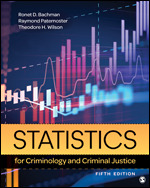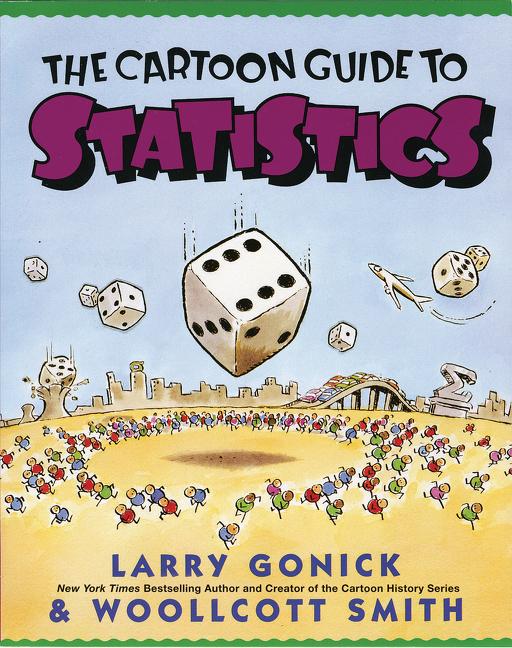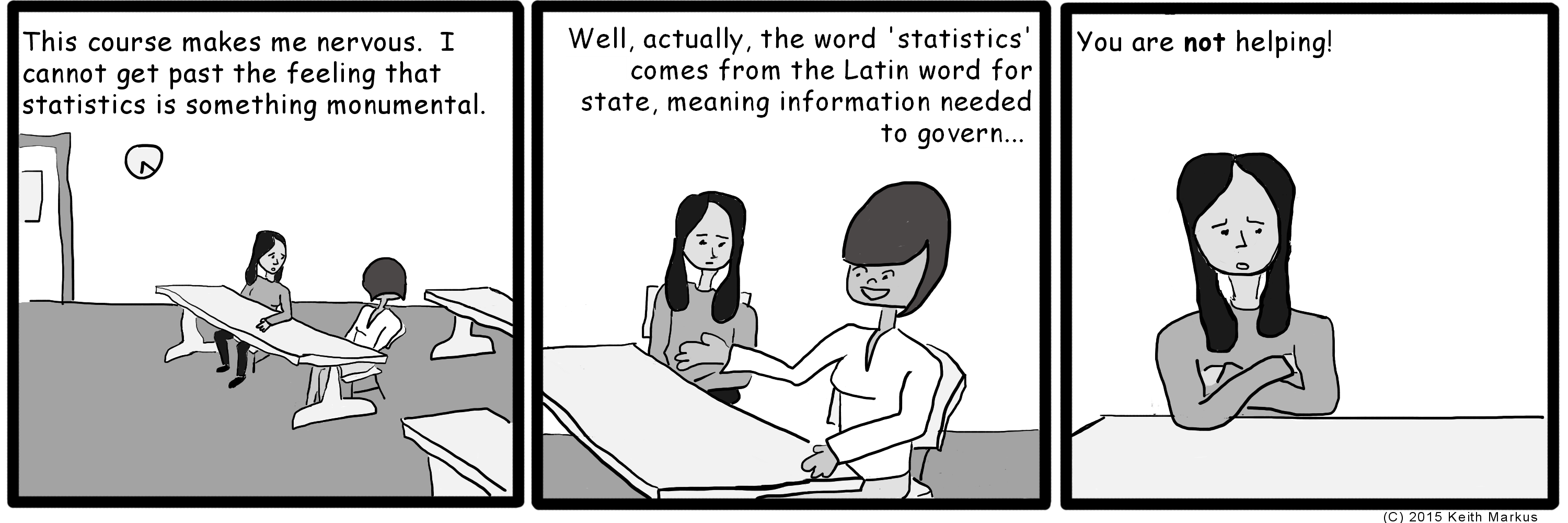"The primary purpose of the course is to
educate students about basic [statistical] theories and
techniques used in the behavioral sciences. The instructor
will briefly review information typically covered in
undergraduate statistics, and then introduce more advanced
statistical techniques. Upon completion, the student is
expected to understand the theoretical underpinnings for the
various statistical techniques and the assumptions that data
must meet to validly use these statistics. The student will
also gain an introduction to computer-based statistical
analysis. 30 hours. 3 credits." (from
Graduate Bulletin)
Many students enter the course several
years after having taken an undergraduate statistics
course. Moreover, new material often precedes review
material in order of logical development. As a
consequence, we will "briefly review" introductory material
as if it were new material and do so for most of the
semester. Nonetheless, from the start, we will cover
most of the material in more depth than a typical
undergraduate course. We will cover a number of topics
not included in a typical introductory course.
Computer based statistical analysis will
largely be limited to the use of spreadsheets. This is
because we offer another course entirely devoted to the
topic of computer based statistical analysis (PSY
737). I highly recommend that course to both thesis
and non-thesis students. Other advantages to
spreadsheets include the fact that you can easily look at
the formulas to know exactly what they are doing,
spreadsheets can be tailored to the course, kept simple and
focused, and thanks to open source office suites like Libre
Office, you can take them wherever you go without any need
for licenses to use commercial software.
Course
Objectives
1. Students will learn to view psychological phenomena from
the perspective of quantitative stochastic processes.
2. Students will develop linguistic competence in
interpreting, describing, and critically evaluating basic
statistical data.
3. Students will gain experience reasoning from and about
numerical data.
Note: It is not possible for this
course to cover all of the statistics that you might need
for a thesis. If you plan on doing a thesis, prepare
yourself for the fact that your data analysis will likely
involve at least some statistics not covered in this
course. See Blackboard for a document comparing what
it covered in this course to other benchmarks.
Required Background Knowledge
This course assumes familiarity with basic math and
algebra. Please take the Basic Math and Algebra
Screening Test on Blackboard. Let me know if the
questions are unfamiliar to you or if you find the test
difficult. If so, it may be wise to talk to your
program head about taking an undergraduate math course this
term and registering for this course in a later term.
Required Reading
Bachman, R & Paternoster, R. (2016).
Statistical methods for criminology and criminal justice (5th
ed.). Thousand Oaks, CA: Sage Publications. (Caution: If you rent, make sure
that the rental term reaches through finals week.)
Please make sure that you get the 5th edition. A number
of typographical errors have been corrected and some material
has been changed.
Substantial additional materials will be posted on
Blackboard. Some course content is covered only in the
additional materials.
Suggested Reading
Software
I strongly recommend that students
install the free office suite Libre Office and use the Calc spreadsheet program (https://www.libreoffice.org/).
I will also post Microsoft Excel versions of the spreadsheets
but Microsoft is breaking backward compatibility and I can no
longer guarantee that the spreadsheets will be completely
functional in Excel. The programs are very similar, but
there are some important differences.
Such spreadsheet software remains a popular
choice for data entry even
among researchers who use more specialized statistical
software for data analysis (the topic of PSY 737). However,
research shows that specialized statistical software can be more confusing
than enlightening when learning
fundamental
statistical concepts.
Excel/Calc offer a
simple computing environment for working with
data ideal for learning and gaining confidence
with fundamental
statistical
concepts. (Mac
users: You can open
both Excel and Calc files
using the Mac version of
LibreOffice. However
the spreadsheets will not
work in Numbers.)
Additional optional software will be explained on
Blackboard. (You will need a computer that is capable of
running locally installed software to complete the
assignments. A digital device that relies entirely on
web applications will not suffice.)
Internet Connection and Online Course
Software
Students will need to be able to download files from
Blackboard onto a computer with spreadsheet software
installed. Blackboard is accessible through the CUNY
portal: www.cuny.edu and
works best with the Mozilla
Firefox browser.
Class Time
The course design is a "flipped
classroom". I will not lecture. Instead, I will
post instructional materials associated with each week on
Blackboard for you to use outside of class. We will
use class time to (a) answer your questions, (b) work on
practice problems, (c) review the quizzes and T&F
questions from the presentation slides, and (d) other
activities to help reinforce learning.
Do the reading before the corresponding class. If you
have questions about the reading, bring them to class and I
will try to answer them there (ideally by posting them to a
discussion board on Blackbaord). I want to leave some
flexibility to use the class time in the manner you will find
most useful. Note, most students need to read each
chapter more than once. Only the first time through the
reading need precede the corresponding class.
Asking effective questions: Try to
formulate questions in an effective manner. If you ask
me to explain some topic, especially a fairly general one, I
will probably give a brief overview and refer you to the
appropriate passages from the textbook or instructional
materials. This is not an effective question (unless
that is what you are after) because you are not giving me
clear information about what you do not understand, leaving me
to guess or just duplicate what you can find elsewhere.
If something was unclear to you there, it is likely to be
equally unclear in my answer. Instead, try to be as
specific as you can about what you do not understand. If
you do not understand a particular term, tell me what you find
confusing about it. If you do not understand a
particular sentence or paragraph, cite the passage and explain
why it does not make sense to you. If you are confused
about a particular statistical analysis, explain the step that
you find unclear and what you think that the possible options
are. The more context and detail that you can give me,
the better the chances that I can give an answer that is
helpful and informative to you and to other students in the
class with similar questions.
If you questions is related to an assignment,
phrase your question in a way that does not involve any
spoilers for other students working on the same
assignment. If in doubt, email me privately rather than
directly posting on a discussion board. I will then
paste an anonymized and, if necessary, edited version of the
question and answer to the disucssion board.
Feel free to search for answers on the
Web. However, please do not attempt to post questions
related to the course using online fora like Cross Validated
or Stack Overflow. These are precious resources
maintained by busy people donating their time and
expertise. It is not appropriate to lean on them for
questions related to a course when you have ready access to an
instructor. Save that for later in your career when you
are no longer a student. (Also, you will probably get a
terse answer that either refers you to introductory material
or assumes more background knowledge than you currently
have.) You should be able to complete assignments based
on the provided course materials but if you make use of
additional resources be sure to credit them in what you turn
in (see Academic Integrity).
Finally, everyone from me to your class mates
are depending on you to ask questions when you have
them. If you have a question, you can be fairly sure
that others have the same question. Your question is not
a "dumb question" but asking the question is the smartest
thing that you can do. Everyone else will appreciate
your having asked the question.
Non-Class Time
I recommend that you begin each week by reading the chapter
once through for the first time. From there, move to the
online instructional materials. These are organized into
subtopics which you can often explore in an order of your
choosing. In many ways, learning statistics is like
learning to skate board, ride a bike, or bake a cake: You can
read about it from a book but you really need to practice to
develop any skill. So, I strongly recommend taking time
to play around with the spreadsheet calculators provided each
week, plugging in different numbers and trying things out for
yourself. Instructional materials primarily include: (a)
pdf handouts, (b) spreadsheet workbooks and (c) videos.
I will also provide links each week to StatQuest
videos on related topics. Finish the first reading of
the chapter and the instructional materials before class meets
on Thursday. Use what you learn to complete the
Application assignment and to formulate questions to ask in
class. After class, I recommend completing the weekly
quiz before the start of the next week, to get it out of the
way. I recommend completing at least one or two quests
prior to taking the quiz because these are an excellent way to
check your understanding of the material and to gain a deeper
understanding of it.
Academic Integrity Attestation
This is a non-graded course requirement. No other
assignments will be accepted for credit unless this form is
completed, signed and submitted. The form is available
on the Blackbaord course and attests that you understand the
principles of academic integrity and will abide by them in
completing all course work involved in this course. (See
further information near the end of the syllabus.)
Application Assignments
Weekly application assignments will appear on Blackboard in
the folder for each week. See Schedule
for due dates. These will be relatively short
assignments applying the material for that week. You can
complete them in a word processing program (or simple text
editor) and upload the file to Blackboard using the Blackboard
Assignment Tool in the same location. PDF (portable
document format) files are great because special characters
are stored internally. I can probably also open RTF
(rich text format), ODT (open document text), DOC (old
Microsoft Office format) and DOCX (new Microsoft Office
format) but these are riskier (e.g., if you use a font I do
not have). If I cannot open a file, or it appears
jumbled, I will accept it as on time but send an email request
for a PDF file.
Quizzes
Weekly quizzes will comprise six questions. When there are two
chapters, there will be three questions from each chapter.
The quizzes will be available on Blackboard in the folder for
the week that they test (not the week that they are due!).
See Schedule for due dates. Your total
quiz grade is equal to the mean proportion correct across all
quizzes after dropping the two lowest quiz grades. See
Blackboard for a more detailed description of quiz items.
You only get one try at a quiz. So, I strongly recommend
completing all other assignments and mastering the material
through further study before taking the quiz. You are
allowed to use your notes, textbook, and other instructional a
materials while taking a quiz, but they are not required to
complete the quiz.
Note: We will go over quizzes in class after they are
due. As a result, there can be no late quizzes. This
will be a hard and fast deadline because delays in going over
the quizzes are very disruptive to other students. If you
miss a quiz for some reason, it will be counted toward the two
lowest grades that you can drop. If you miss three or more
quizzes, the zero grade will count toward your course
grade. So, stay on top of the deadlines and be sure to
complete quizzes before the deadline (see schedule for specific
times of day and dates). Caution: I discourage waiting
until the last minute because if you have not submitted the quiz
by the deadline according to Blackboard's internal clock, you
will be prevented from ever submitting it even if you have
answered all the questions.
Quests
There are four quests available for each chapter of the
book. They are available as separate worksheets in a
workbook containing all quests for that chapter. Each quest
workbook also contains an overview worksheet listing the quests
and also a Statisticians' Guild worksheet which contains hints,
resources, and your scores.
You are required to complete an average of 3 quests for each
chapter within each of the three sections of the course. Any
grade better than "incomplete" counts as completing a quest (but I
encourage you to go for "perfect!"). You will not receive
credit for an incomplete quest even if you have completed a
portion of it. You may complete additional quests prior to
the deadline for that chapter for extra credit (see Power Up in grading section). The course is divided
roughly into thirds. You can continue turning in quests up
until the deadline for that third of the course. Once the
deadline passes, no more quests for that third of the course can
receive credit. See Schedule for due
dates.
To turn in quests for a given chapter, upload your entire workbook
using the Blackboard Assignment tool for quests for that
week. This will be found in the folder for the week
corresponding to the quests. When a week contains two
chapters, there will be two separate places to turn in each quest
workbook. Please do not convert quest worksheets to PDF
files, turn them in in their original format. Please also
check your grades before you turn in your quest workbook.
Just because you filled in answers to all the questions that does
not mean that you successfully completed the quest!
In-class Practice Problems
We will work on practice problems in class that are also part of
the same continuous Chifferton universe as are the quests.
These will also be distributed as spreadsheets. You can
download these from Blackboard at the start of class or bring them
on an external storage device. These are not the same as
quests and they are not graded assignments. They are
strictly for learning purposes.
Grading
Your final grade comprises your Application
Assignment grade, your Quiz grade, your Quest grade for each
of the three parts of the course, and your Power Up. The
Application grade counts each of the 12 application
assignments as 1 point and equals the sum of these divided by
12. The Quiz grade counts each quiz as 1 point, drops
the 2 lowest, and divides the sum by 10. The Quest grade
for each part is the number of quests that you (successfully)
completed (again, not just turned in with answers). You
are required to complete 15 quests for Part 1 and for Part 2,
and 12 quests for Part 3. Your final grade is based on
the proportion of the required quests completed in each
part. Specifically, I calculate min(N, F) / N where N is
the minimum required quests (15 or 12) and F the number of
completed quests for that part of the course. The Power
Up is calculated based on extra quests beyond those
required. Here, I calculate max(0, F - N) for each part
of the course, add them together, and divide by 14. As
such, you can never loose points with a negative Power Up, it
will never fall below zero. The Power Up reflects the
extra quests you complete beyond those required for each part
of the course (not by individual chapter). Caution: All
of this is contingent on your submitting the required Acacemic
Integreity Attenstation form.
Your Numeric Course Grade is calculated from
the above scores as follows: (.25 * Application
Assignments) + (.25 * Quizzes) + (.17 * Part 1 Quests) + (.17
* Part 2 Quests) + (.16 * Part 3 Quests) + (.05 * Power
Up). In words, Applications and Quizzes both count 25%
of your grade, required Quests count for 50%, and you can earn
up to 5% extra credit by completing extra quests. There
will be no other extra credit options beyond Power Ups.
I will use the following chart
to convert Numeric Course Grades to Letter Course
Grades. On the proportion (not percent) scale, I will
round .xx5 and above up and anything below .xx5 down.


